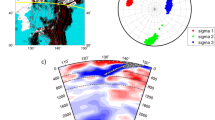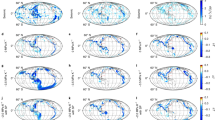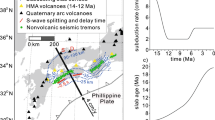Abstract
Global seismic tomography of the subduction zones shows that the subducting slabs could either stagnate around the 660-km discontinuity, or penetrate into the lower mantle. The stagnating slabs also have various morphologies. These are directly related to the interaction between the subducting slabs and the mantle transition zone (MTZ), the dynamics of which are still debated. Using a 2-D thermo-mechanical model, we systematically investigated the modes of subduction in the mantle transition zone and explored the key constraints of various subduction styles. Four basic subduction modes are obtained in the numerical experiments, including one with slab penetrating through the 660-km discontinuity and three other modes with slab stagnating in the MTZ (i.e. folding, lying and rolling-back). The numerical models indicate that the age of subducting oceanic plate, the thickness of overriding continental lithosphere and the convergence velocity play crucial roles in the dynamics of subducting slab and MTZ interaction. In general, the young subducting slab favors the penetration or folding mode, whereas the old subducting slab tends to result in lying or rolling-back mode, although other parameters can also affect. Our models also show a strong correlation between the subduction mode selection and dip angle of the slab tip when reaching the 660-km phase boundary.









Similar content being viewed by others

References
Agrusta, R., Goes, S., & van Hunen, J. (2017). Subducting-slab transition-zone interaction: Stagnation, penetration and mode switches. Earth and Planetary Science Letters, 464, 10–23.
Agrusta, R., van Hunen, J., & Goes, S. (2014). The effect of metastable pyroxene on the slab dynamics. Geophysical Research Letters, 41(24), 8800–8808.
Arredondo, K. M., & Billen, M. I. (2016). The effects of phase transitions and compositional layering in two-dimensional kinematic modes of subductiion. Journal of Geodynamics, 100, 159–174.
Arredondo, K. M., & Billen, M. I. (2017). Coupled effects of phase transitions and rheology in 2-D dynamical models of subduction. Journal of Geophysical Research: Solid Earth, 122(7), 5813–5830.
Bittner, D., & Schmeling, H. (1995). Numerical modelling of melting processes and induced diapirism in the lower crust. Geophysical Journal International, 123, 59–70.
Bellahsen, N., Faccenna, C., & Funiciello, F. (2005). Dynamics of subduction and plate motion in laboratory experiments: Insights into the “plate tectonics” behavior of the earth. Journal of Geophysical Research, 110, B01401. https://doi.org/10.1029/2004JB002999.
Billen, M. I. (2008). Modeling the dynamics of subducting slabs. Annual Review of Earth and Planetary Sciences, 36, 325–356.
Billen, M. I. (2010). Slab dynamics in the transition zone. Physics of the Earth and Planetary Interiors, 183(1–2), 296–308.
Billen, M. I., & Hirth, G. (2007). Rheologic controls on slab dynamics. Geochemistry, Geophysics, Geosystems, 8, Q08012. https://doi.org/10.1029/2007GC001597.
Bina, C. R., & Helffrich, G. (1994). Phase transition Clapeyron slopes and transition zone seismic discontinuity topography. Journal of Geophysical Research, 99(B8), 15853–15860.
Capitanio, F., Morra, G., & Goes, S. (2007). Dynamic models of downgoing plate-buoyancy driven subduction: Subduction motions and energy dissipation. Earth and Planetary Science Letters, 262(1–2), 284–297.
Capitanio, F. A., Stegman, D. R., Moresi, L. N., & Sharples, W. (2010). Upper plate controls on deep subduction, trench migrations and deformations at convergent margins. Tectonophysics, 483(1–2), 80–92.
Chen, J., & King, S. D. (1998). The influence of temperature and depth dependent viscosity on geoid and topography profiles from models of mantle convection. Physics of the Earth and Planetary Interiors, 106(1–2), 75–92.
Chopelas, A. (1991). Thermal properties of β-Mg2SiO4 at mantle pressures derived from vibrational spectroscopy: Implications for the mantle at 400 km depth. Journal of Geophysical Research, 96, 11817–11829.
Christensen, U. R. (1996). The influence of trench migration on slab penetration into the lower mantle. Earth and Planetary Science Letters, 140(1–4), 27–39.
Christensen, U. R., & Yuen, D. A. (1984). The interaction of a subducting lithospheric slab with a chemical or phase boundary. Journal of Geophysical Research, 89(B6), 4389–4402.
Christensen, U. R., & Yuen, D. A. (1985). Layered convection induced by phase transitions. Journal of Geophysical Research, 90(B12), 10291–10300.
Clauser, C., & Huenges, E. (1995). Thermal conductivity of Rocks and Minerals. Americal Geophysical Union.
Čížková, H., & Bina, C. R. (2013). Effects of mantle and subduction-interface rheologies on slab stagnation and trench rollback. Earth and Planetary Science Letters, 379, 95–103.
Čížková, H., van Hunen, J., & van den Berg, A. (2007). Stress distribution within subducting slabs and their deformation in the transition zone. Physics of the Earth and Planetary Interiors, 161(3–4), 202–214.
Čížková, H., van Hunen, J., van den Berg, A. P., & Vlaar, N. J. (2002). The influence of rheological weakening and yield stress on the interaction of slabs with the 670 km discontinuity. Earth and Planetary Science Letters, 199(3–4), 447–457.
Clark, S. R., Stegman, D., & Müller, R. D. (2008). Episodicity in back-arc tectonic regimes. Physics of the Earth and Planetary Interiors, 171(1–4), 265–279.
Di Giuseppe, E., van Hunen, J., Funiciello, F., Faccenna, C., & Giardini, D. (2008). Slab stiffness control of trench motion: Insights from numerical models. Geochemistry, Geophysics, Geosystems, 9, Q02014. https://doi.org/10.1029/2007GC001776.
Dziewonski, A. M., & Anderson, D. L. (1981). Preliminary reference earth model. Physics of the Earth and Planetary Interiors, 25, 297–356.
Fukao, Y., & Obayashi, M. (2013). Subducted slabs stagnant above, penetrating through, and trapped below the 660 km discontinuity. Journal of Geophysical Research, Solid Earth, 118(11), 5920–5938.
Fukao, Y., Obayashi, M., Inoue, H., & Nenbai, M. (1992). Subducting slabs stagnant in the mantle transition zone. Journal of Geophysical Research, 97(B4), 4809–4822.
Garel, F., Goes, S., Davies, D. R., Davies, J. H., Kramer, S. C., & Wilson, C. R. (2014). Interaction of subducted slabs with the mantle transition-zone: Aregime diagram from 2-D thermo-mechanical models with a mobile trench and an overriding plate. Geochemistry, Geophysics, Geosystems, 15(5), 1739–1765.
Gerya, T. V. (2010). Introduction to numerical geodynamic modelling. Cambridge: Cambridge University Press.
Gerya, T. V., & Meilick, F. I. (2011). Geodynamic regimes of subduction under an active margin: Effects of rheological weakening by fluids and melts. Journal of Metamorphic Geology, 29(1), 7–31.
Gerya, T. V., & Yuen, D. A. (2003). Characteristics-based marker-in-cell method with conservative finite-differences schemes for modeling geological flows with strongly variable transport properties. Physics of the Earth and Planetary Interiors, 140(4), 293–318.
Gerya, T. V., & Yuen, D. A. (2007). Robust characteristics method for modeling multiphase visco-elasto-plastic thermo-mechanical problems. Physics of the Earth and Planetary Interiors, 163(1–4), 83–105.
Gerya, T. V., Yuen, D. A., & Maresch, W. V. (2004). Thermomechanical modeling of slab detachment. Earth and Planetary Science Letters, 226(1–2), 101–116.
Goes, S., Agrusta, R., van Hunen, J., & Garel, F. (2017). Subduction-transition zone interaction: A review. Geosphere, 13(3), 644–664.
Goes, S., Capitanio, F. A., & Morra, G. (2008). Evidence of lower-mantle slab penetration phases in plate motions. Nature, 451, 981–984.
Grand, S. P., van der Hilst, R. D., & Widiyantoro, S. (1997). Global seismic tomography: A snapshot of convection in the Earth. GSA Today, 7(4), 1–7.
Griffiths, R. W., Hackney, R., & van der Hilst, R. D. (1995). A laboratory investigation of trench migration and the fate of subducted slabs. Earth and Planetary Science Letters, 133(1–2), 1–17.
Gurnis, M., & Hager, B. H. (1988). Controls on the structure of subducted slabs. Nature, 335, 317–321.
Holt, A. F., Becker, T. W., & Buffett, B. A. (2015). Trench migration and overriding plate stress in dynamic subduction models. Geophysical Journal Internatonal, 201(1), 172–192.
Huang, J. L., & Zhao, D. P. (2006). High-resolution mantle tomography of China and surrounding regions. Journal of Geophysical Research, 111, B09305. https://doi.org/10.1029/2005JB004066.
Huangfu, P., Wang, Y., Cawood, P. A., Li, Z. H., Fan, W., & Gerya, T. V. (2016). Thermo-mechanical controls of flat subduction: Insights from numerical modeling. Gondwana Research, 40, 170–183.
Ita, J. J., & King, S. D. (1994). The sensitivity of convection with an endothermic phase change to the form of governing equations, initial conditions, aspect ratio, and equation of state. Journal of Geophysical Research, 99(B8), 15919–15938.
Ito, E., Akaogi, M., Topor, L., & Navrotsky, A. (1990). Negative pressure-temperature slopes for reactions forming MgSiO3 perovskite from calorimetry. Science, 249, 1275–1278.
Ito, E., & Takahashi, E. (1989). Postspinel transformations in the system Mg2SiO4–Fe2SiO4 and some geophysical implications. Journal of Geophysical Research, 94, 10637–10646.
Karato, S., Riedel, M. R., & Yuen, D. A. (2001). Rheological structure and deformation of subducted slabs in the mantle transition zone: Implications for mantle circulation and deep earthquakes. Physics of the Earth and Planetary Interiors, 127(1–4), 83–108.
Karato, S., & Wu, P. (1993). Rheology of the upper mantle: A synthesis. Science, 260(5109), 771–778.
Katayama, I., & Karato, S. I. (2008). Low-temperature, high-stress deformation of olivine under water-saturated conditions. Physics of the Earth and Planetary Interiors, 168(3–4), 125–133.
Katsura, T., & Ito, E. (1989). The system Mg2SiO4–Fe2SiO4 at high pressures and temperatures: Precise determination of stabilities of olivine, modified spinel, and spinel. Journal of Geophysical Research, 94, 15663–15670.
King, S. D., Frost, D. J., & Rubie, D. C. (2015). Why cold slabs stagnate in the transition zone. Geology, 43(3), 231–234.
King, S. D., & Ita, J. J. (1995). The effect of slab rheology on mass transport across a phase transition boundary. Journal of Geophysical Research, 100(B10), 20211–20222.
Kocks, U. F., Argon, A. S., & Ashby, M. F. (1975). Thermodynamics and kinetics of slip. Progress in Materials Science, 19, 1–281.
Kirby, S. H., & Kronenberg, A. K. (1987). Rheology of the lithosphere: selected topics. Review of Geophysics, 25, 1219–1244.
Lallemend, S., Heuret, A., Faccenna, C., & Funiciello, F. (2008). Subduction dynamics as revealed by trench migration. Tectonics, 27, TC3014. https://doi.org/10.1029/2007tc002212.
Lee, C., & King, S. D. (2011). Dynamic buckling of subducting slabs reconciles geological and geophysical observations. Earth and Planetary Science Letters, 312(3–4), 360–370.
Li, Z. H. (2014). A review on the numerical geodynamic modeling of continental subduction, collision and exhumation. Science China: Earth Sciences, 57(1), 47–69.
Li, Z. H., Di Leo, J. F., & Ribe, N. M. (2014). Subduction-induced mantle flow, finite strain and seismic anisotropy: Numerical modeling. Journal of Geophysical Research: Solid Earth, 119(6), 5052–5076.
Li, Z. H., & Gerya, T. V. (2009). Polyphase formation and exhumation of high- to ultrahigh-pressure rocks in continental subduction zone: Numerical modeling and application to the Sulu ultrahigh-pressure terrane in eastern China. Journal of Geophysical Research: Solid Earth, 114, B09406. https://doi.org/10.1029/2008JB005935.
Li, Z. H., Liu, M. Q., & Gerya, T. V. (2015). Material transportation and fluid-melt activity in the subduction channel: numerical modeling. Science China: Earth Sciences, 58, 1251–1268.
Li, Z. H., Liu, M., & Gerya, T. V. (2016). Lithosphere delamination in continental collisional orogens: A systematic numerical study. Journal of Geophysical Research: Solid Earth, 121(7), 5186–5211.
Li, Z. H., & Ribe, N. M. (2012). Dynamics of free subduction from 3-D boundary-element modeling. Journal of Geophysical Research: Solid Earth, 117, B06408. https://doi.org/10.1029/2012JB009165.
Li, C., van der Hilst, R. D., Engdahl, E. R., & Burdick, S. (2008). A new global model for P wave speed variations in Earth’s mantle. Geochemistry, Geophysics, Geosystems, 9, Q05018. https://doi.org/10.1029/2007GC001806.
Liu, M. Q., Li, Z. H., & Yang, S. H. (2017). Diapir versus along-channel ascent of crustal material during plate convergence: Constrained by the thermal structure of subduction zones. Journal of Asian Earth Sciences, 145(A), 16–36.
Manea, V. C., Pérez-Gussinyé, M., & Manea, M. (2012). Chilean flat slab subduction controlled by overriding plate thickness and trench rollback. Geology, 40(1), 35–38.
Mosenfelder, J. L., Marton, F. C., Ross, C. R., Kerschhofer, L., & Rubie, D. C. (2001). Experimental constraints on the depth of olivine metastability in subducting lithosphere. Physics of the Earth and Planetary Interiors, 127(1–4), 165–180.
Muller, R. D., Sdrolias, M., Gaina, C., & Roest, W. R. (2008). Age, spreading rates and spreading asymmetry of the world’s ocean crust. Geochemistry, Geophysics, Geosystems, 9, Q04006. https://doi.org/10.1029/2007GC001743.
Nakakuki, T., Tagawa, M., & Iwase, Y. (2010). Dynamical mechanisms controlling formation and avalanche of a stagnant slab. Physics of the Earth and Planetary Interiors, 183(1–2), 309–320.
Nakao, A., Iwamori, H., & Nakakuki, T. (2016). Effects of water transportation on subduction dynamics: Role of viscosity and density reduction. Earth and Planetary Science Letters, 454, 178–191.
O’Driscoll, L. J., Richards, M. A., & Humphreys, E. D. (2012). Nazca-South America interactions and the late Eocene-late Oligocene flat-slab episode in the central Andes. Tectonics, 31, TC2013. https://doi.org/10.1029/2011tc003036.
Ranalli, G. (1995). Rheology of the earth, deformation and flow process in geophysics and geodynamics (2nd ed., p. 413). London: Chapman & Hall.
Ribe, N. M. (2007). Analytical approaches to mantle dynamics. Treatise on Geophysics, 7, 167–226.
Ribe, N. M. (2010). Bending mechanics and mode selection in free subduction: A thin-sheet analysis. Geophysical Journal Internatonal, 180(2), 559–576.
Ricard, Y., Richards, M., Lithgow-Bertelloni, C., & Le Stunff, Y. (1993). A geodynamic model of mantle density heterogeneity. Journal of Geophysical Research, 98(B12), 21895–21909.
Roda, M., Marotta, A. M., & Spalla, M. I. (2011). The effects of the overriding plate thermal state on the slab dip in an ocean-continent subduction system. Comptes Rendus Geoscience, 343(5), 323–330.
Rodríguez-González, J., Billen, M. I., & Negredo, A. M. (2014). Non-steady-state subduction and trench parallel flow induced by overriding plate structure. Earth and Planetary Science Letters, 401, 227–235.
Rodríguez-González, J., Negredo, A. M., & Billen, M. I. (2012). The role of the overriding plate thermal state on slab dip variability and on the occurrence of flat subduction. Geochemistry, Geophysics, Geosystems, 13, Q01002. https://doi.org/10.1029/2011GC003859.
Schellart, W. P. (2008). Kinematics and flow patterns in deep mantle and upper mantle subduction models: Influence of the mantle depth and slab to mantle viscosity ratio. Geochemistry, Geophysics, Geosystems, 9, Q03014. https://doi.org/10.1029/2007GC001656.
Schellart, W. P. (2010). Evolution of subduction zone curvature and its dependence on the trench velocity and the slab to upper mantle viscosity ratio. Journal of Geophysical Research, 115, B11406. https://doi.org/10.1029/2009JB006643.
Schmeling, H., Babeyko, A. Y., Ennsa, A., Faccenna, C., Funiciello, F., Gerya, T., et al. (2008). A benchmark comparison of spontaneous subduction models-Towards a free surface. Physics of the Earth and Planetary Interiors, 171(1–4), 198–223.
Schmeling, H., Monz, R., & Rubie, D. C. (1999). The influence of olivine metastability on the dynamics of subduction. Earth and Planetary Science Letters, 165(1), 55–66.
Stegman, D. R., Farrington, R., Capitanio, F. A., & Schellart, W. P. (2010). A regime diagram for subduction styles from 3-D numerical models of free subduction. Tectono-physics, 483(1–2), 29–45.
Tackley, P. J., Stevenson, D. J., Glatzmaier, G. A., & Schubert, G. (1993). Effects of an endothermic phase transition at 670 km depth in a spherical model of convection in the Earth’s mantle. Nature, 361, 699–704.
Tagawa, M., Nakakuki, T., & Tajima, F. (2007). Dynamical modeling of trench retreat driven by the slab interaction with the mantle transition zone. Earth Planets Space, 59(2), 65–74.
Tetzlaff, M., & Schmeling, H. (2000). The influence of olivine metastability on deep subduction of oceanic lithosphere. Physics of the Earth and Planetary Interiors, 120(1–2), 29–38.
Tetzlaff, M., & Schmeling, H. (2009). Time-dependent interaction between subduction dynamics and phase transition kinetics. Geophysical Journal International, 178, 826–844.
Torii, Y., & Yoshioka, S. (2007). Physical conditions producing slab stagnation: constraints of the Clapeyron slope, mantle viscosity, trench retreat, and dip angles. Tectonophysics, 445(2), 200–209.
Trampert, J., & van der Hilst, R. D. (2005). Towards a quantitative interpretation of global seismic tomography. Earth’s Deep Mantle: Structure, Composition, and Evolution, Geophysical Monograph Series, 160, 47–62.
Turcotte, D. L., & Schubert, G. (2002). Geodynamics. Cambridge: Cambridge University Press.
van der Hilst, R. D. (1995). Complex morphology of subducted lithosphere in the mantle beneath the Tonga trench. Nature, 374, 154–157.
van der Hilst, R. D., & Seno, T. (1993). Effects of relative plate motion on the deep structure and penetration depth of slabs below the Izu-Bonin and Mariana island arcs. Earth and Planetary Science Letters, 120(3–4), 395–407.
van der Hilst, R. D., Widiyantoro, S., & Engdahl, E. R. (1997). Evidence for deep mantle circulation from global tomography. Nature, 386, 578–584.
van der Meer, D. G., Spakman, W., van Hinsbergen, D. J. J., Amaru, M. L., & Torsvik, T. H. (2010). Towards absolute plate motions constrained by lower-mantle slab remnants. Nature Geoscience, 3, 36–40.
van Hunen, J., van der Berg, A. P., & Vlaar, N. J. (2004). Various mechanisms to induce present-day flat subduction and implications for the younger earth: A numerical parameter study. Physics of the Earth and Planetary Interiors, 146(1–2), 179–194.
Vogt, K., Gerya, T. V., & Castro, A. (2012). Crustal growth at active continental margins: Numerical modeling. Physics of the Earth and Planetary Interiors, 192–193, 1–20.
Zhong, S., & Gurnis, M. (1997). Dynamic interaction between tectonic plates, subducting slabs, and the mantle. Earth Interactions, 1, 3–18.
Acknowledgements
This work was funded by the project of National Natural Science Foundation of China (Grant nos. 41474086, 41622404, 41590865), and the CAS/CAFEA international partnership program for creative research teams (KZZD-EW-TZ-19). Constructive reviews by Dr. Magali Billen and an anonymous reviewer are greatly appreciated.
Author information
Authors and Affiliations
Corresponding authors
Rights and permissions
About this article
Cite this article
Shi, Y., Wei, D., Li, ZH. et al. Subduction Mode Selection During Slab and Mantle Transition Zone Interaction: Numerical Modeling. Pure Appl. Geophys. 175, 529–548 (2018). https://doi.org/10.1007/s00024-017-1762-0
Received:
Revised:
Accepted:
Published:
Issue Date:
DOI: https://doi.org/10.1007/s00024-017-1762-0



